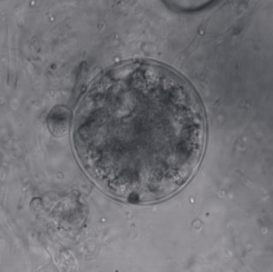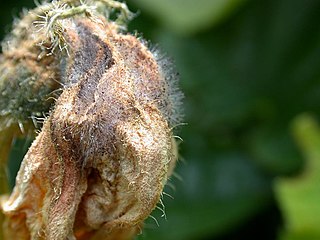Related Research Articles

Mycology is the branch of biology concerned with the study of fungi, including their genetic and biochemical properties, their taxonomy and their use to humans, including as a source for tinder, traditional medicine, food, and entheogens, as well as their dangers, such as toxicity or infection.

Chytridiomycota are a division of zoosporic organisms in the kingdom Fungi, informally known as chytrids. The name is derived from the Ancient Greek χυτρίδιον, meaning "little pot", describing the structure containing unreleased zoöspores. Chytrids are one of the early diverging fungal lineages, and their membership in kingdom Fungi is demonstrated with chitin cell walls, a posterior whiplash flagellum, absorptive nutrition, use of glycogen as an energy storage compound, and synthesis of lysine by the α-amino adipic acid (AAA) pathway.
The Halosphaeriaceae are a family of fungi in the Sordariomycetes class, subclass Hypocreomycetidae. As of 2015, Halosphaeriaceae is the family with the largest number of marine fungi, with 141 species distributed among 59 genera.
Sablicola is a fungal genus in the family Halosphaeriaceae. It is a monotypic genus, containing the single species Sablicola chinensis, described as new to science in 2004. This is a marine fungus that was collected from brackish water in the Pearl River Estuary in southern China. It features ascospores that have two polar and four equatorial, flattened, attenuate, strap-like appendages with parallel striations. These striations break down into fine threads when mounted in seawater.

Verrucaria is a genus of lichenized (lichen-forming) fungi in the family Verrucariaceae.
Crinigera is a genus of fungi in the division Ascomycota. The relationship of this taxon to other taxa within the phylum is unknown, and it has not yet been placed with certainty into any class, order, or family. This is a monotypic genus, containing the single species Crinigera maritima. Crinigera maritima is a marine ascomycota fungus species with characteristic appendaged cleistothecia and ascospores that cling onto substrates of wood, algae, or sand. It is found in the mesohaline zone of many different coastal countries. It has been mistaken for a new fungal species Dryosphaera navigans and has yet to be assigned to a class, order, or family.

Marine fungi are species of fungi that live in marine or estuarine environments. They are not a taxonomic group, but share a common habitat. Obligate marine fungi grow exclusively in the marine habitat while wholly or sporadically submerged in sea water. Facultative marine fungi normally occupy terrestrial or freshwater habitats, but are capable of living or even sporulating in a marine habitat. About 444 species of marine fungi have been described, including seven genera and ten species of basidiomycetes, and 177 genera and 360 species of ascomycetes. The remainder of the marine fungi are chytrids and mitosporic or asexual fungi. Many species of marine fungi are known only from spores and it is likely a large number of species have yet to be discovered. In fact, it is thought that less than 1% of all marine fungal species have been described, due to difficulty in targeting marine fungal DNA and difficulties that arise in attempting to grow cultures of marine fungi. It is impracticable to culture many of these fungi, but their nature can be investigated by examining seawater samples and undertaking rDNA analysis of the fungal material found.
Plasmodiophora bicaudata is a marine pathogen, an obligate parasite of seagrass of the genus Zostera and the causal agent of wasting disease in the genus. These marine plants grow in fine sediment in shallow seas and the pathogen seems to have a worldwide distribution.

Mycoplankton are saprotrophic members of the plankton communities of marine and freshwater ecosystems. They are composed of filamentous free-living fungi and yeasts that are associated with planktonic particles or phytoplankton. Similar to bacterioplankton, these aquatic fungi play a significant role in heterotrophicmineralization and nutrient cycling. Mycoplankton can be up to 20 mm in diameter and over 50 mm in length.

Trichomycetes refers to a group of fungi in the division Zygomycota that grow in the guts of arthropods living in aquatic habitats. The name is obsolete, having not been validly published. Species formerly placed in the Trichomycetes are now placed in the orders Harpellales and Asellariales, both in the suborder subdivision Kickxellomycotina, while Amoebidiales and Eccrinales are included in Opisthokonta.
Candida rhizophoriensis is a yeast species first found in the Florida Everglades.
Rhodotorula cladiensis is a yeast species first found in the Florida Everglades.
Rhodotorula evergladiensis is a yeast species first found in the Florida Everglades.

Hydropunctaria is a genus of saxicolous (rock-dwelling), crustose lichens in the family Verrucariaceae. The genus includes both aquatic and amphibious species, with members that colonise either marine or freshwater habitats. The type species, Hydropunctaria maura, was formerly classified in the large genus Verrucaria. It is a widely distributed species common to littoral zones. Including the type species, five Hydropunctaria lichens are considered marine species: H. adriatica, H. amphibia, H. aractina, H. orae, and H. oceanica.
Wicklowia aquatica is a freshwater fungus species in the genus Wicklowia that is found in Florida and Costa Rica. Wicklowia aquatica produces the depsidone compound folipastatin.
Aigialaceae is a family of marine fungi belonging to the order Pleosporales. Suetrong et al introduced this family in 2009.
Fissuroma is a genus of fungi in the family Aigialaceae.
The Lentitheciaceae are a family of fungi in the order of Pleosporales. They are found world-wide with the greatest contributions found in Europe and Australia.
The Trematosphaeriaceae are a family of fungi in the order of Pleosporales. They are found world-wide with the greatest contributions found in Europe and Australia. It includes taxa that are found in the marine environment, such as Falciformispora lignatis which can be found in freshwater and marine habitats. Most are saprobic species.

The Urocystidales are an order of fungi within the class Ustilaginomycetes. The order contains 6 families and about 400 genera. They are a sister order to Ustilaginales.
References
- ↑ Ainsworth, Geoffrey Clough (2008). Ainsworth & Bisby's Dictionary of the Fungi. CABI. ISBN 9780851998268.
- ↑ Dick, M. W. (2013). Straminipilous Fungi: Systematics of the Peronosporomycetes Including Accounts of the Marine Straminipilous Protists, the Plasmodiophorids and Similar Organisms. Springer Science & Business Media. ISBN 9789401597333.
- ↑ Jones, E. B. Gareth; Pang, Ka-Lai (2012). Marine Fungi: and Fungal-like Organisms. Walter de Gruyter. ISBN 9783110264067.
- ↑ Gleason FH, Letcher PM, Evershed N, McGee PA (2008). "Recovery of growth of Hyphochytrium catenoides after exposure to environmental stress". J. Eukaryot. Microbiol. 55 (4): 351–4. doi:10.1111/j.1550-7408.2008.00331.x. PMID 18681849.